The city of Delft is continually juxtaposed with the birthplace of Jan Vermeer (Delft, 1632 - 1675), the famous painter of the Girl with a Pearl Earring who was born here and spent his entire existence. Simply walking through the streets of Delft one is in fact confronted with the house where he lived with his wife, the artists’ guild to which Vermeer belonged, namely the Guild of St.Lucas (St. Lucas Gilde in Dutch), the building in which he was born, which today houses a restaurant, and the Oude Kerk, the oldest church in the city, where the artist is buried, and whose bell tower is leaning, like the Tower of Pisa.
However, although Vermeer became Delft’s best-known painter, he was not the only one: evidence of this can be seen by going back to the Guild of St. Luke, to which artists necessarily had to “enroll” in order to carry out the more purely commercial activity, in which the Guilds (as these guilds were called) possessed a controlling role in economic trades; indeed,Holland has a great commercial tradition. Membership in an artists’ guild thus gave artists the opportunity to sell their artwork, to hire apprentices in their workshops, and in addition, the guilds could positively influence their careers, as these venues were true centers of discussion and judgment regarding each person’s artistic activity. Located in the various most active centers of Holland, the various seats of the Guild of St. Luke developed especially in the so-called Dutch Golden Age, thus in the seventeenth century; to the one in Delft belonged many artists, including, in addition to Vermeer, Pieter de Hooch, Carel Fabritius, Jan Steen, and Michiel van Mierevelt. And it was precisely Pieter de Hooch (Rotterdam,1629 - Amsterdam, 1684) that we might say was the city’s most significant artist along with Vermeer, his contemporary, although the latter, even today, places him in the shadows, as he is still less well known than the highly successful worldwide painter of the Girl with a Pearl Earring.
This assumption was the starting point for the exhibition Pieter de Hooch in Delft. Beyond Vermeer’s Shadow, (through Feb. 16, 2020 in Delft, at Museum Prinsenhof). The first retrospective in the Netherlands devoted to the artist, it is designed to shine a light on one of the most important masters of the Dutch Golden Age, acquainting the public with the splendid masterpieces that de Hooch created in his city four hundred years ago and that still enchant visitors in front of his depicted courtyards and interiors. On the occasion of the exhibition, about thirty paintings from all over the world, as they are held in the most prestigious museum venues, from the Rijksmuseum in Amsterdam to the National Gallery in London to theHermitage in St. Petersburg, have returned to the place where they were made, and some have even never been exhibited in the Netherlands. This is therefore a major event for the entire city and for the entire field of seventeenth-century Dutch painting, as Museum Prinsenhof director Janelle Moerman herself said, “Never before have we witnessed the return of so many of Pieter de Hooch’s masterpieces to his Delft, the city where the artist created his most beautiful courtyards and interiors almost four hundred years ago. In these works, you can still immerse yourself in the atmosphere of 17th-century Delft with the beautiful buildings and churches.”
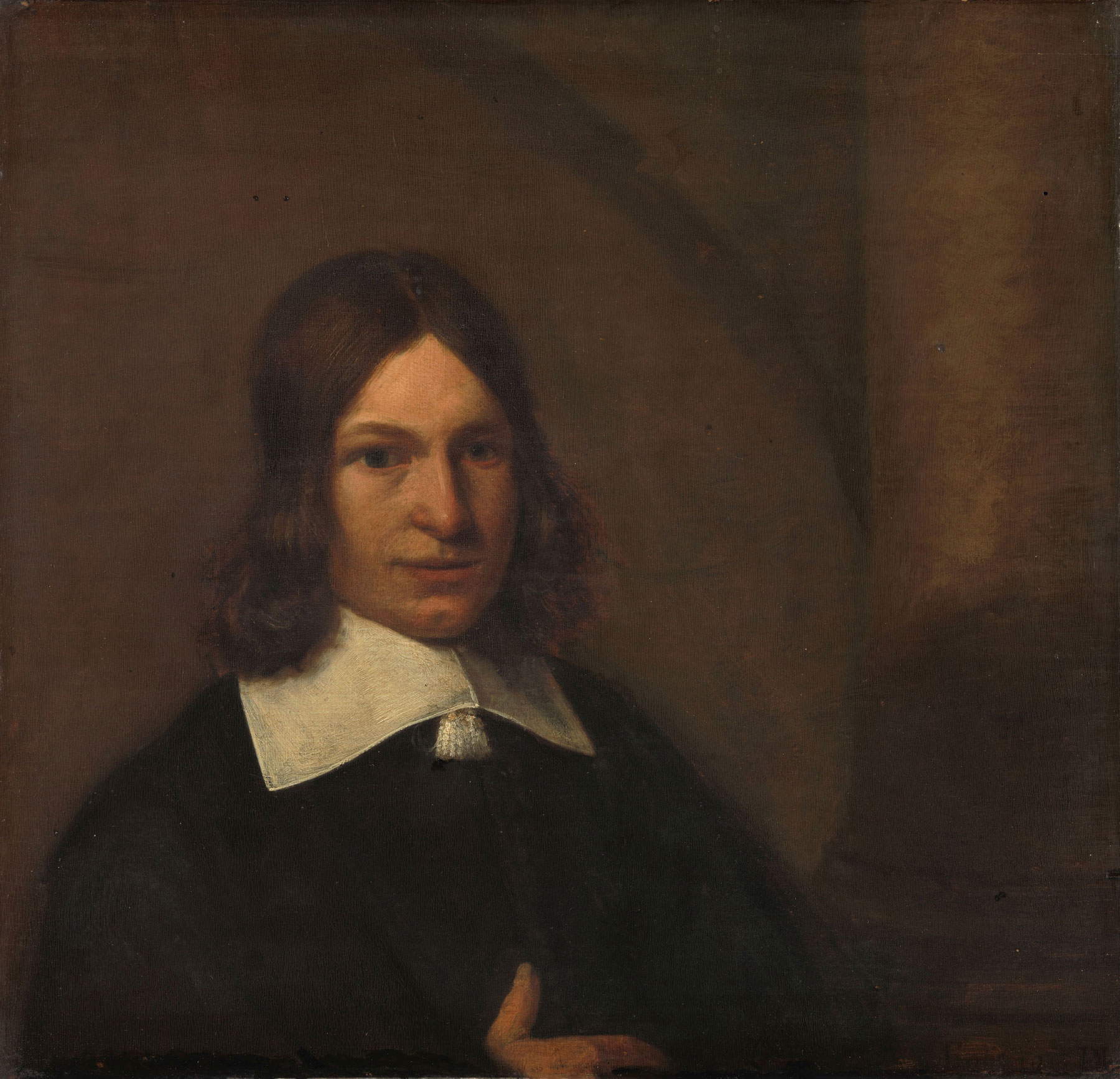 |
| Pieter de Hooch (attributed), Self-Portrait? (1648-1649; oil on panel, 32.5 x 34 cm; Amsterdam, Rijksmuseum) |
 |
| Hall of the exhibition on Pieter de Hooch in Delft. Ph. Credit Finestre Sull’Arte |
 |
| Hall of the exhibition on Pieter de Hooch in Delft. Ph. Credit Finestre Sull’Arte |
The earliest record of the artist in Delft, where he lived, dates from 1652, but de Hooch was born in Rotterdam in 1629 to a father who was a bricklayer and a mother who was a midwife: no artistic influence, therefore, from his parents. Instead, his teacher was landscape painter Nicolaes Pietersz Berchem (Haarlem, 1620 - Amsterdam, 1683), with whom he served his apprenticeship in Harleem. Upon arriving in Delft, de Hooch acted as dienaar, as assistant, to Justus de la Grange, a wealthy merchant in whose collection in Delft and Leiden already included eleven of the artist’s paintings at that time. He married Jannetje van der Burch, probably sister of the painter Hendrick van der Burch (Delft, 1627 - 1664), and the couple gave birth to seven children.
Instead, it is documented in 1655 that the artist joined the famous Guild of St. Luke, where he probably met Vermeer. He remained in the Dutch town until about 1660 and then moved for the rest of his life, until 1684, to Amsterdam, with the exception of a few sporadic stays in Delft.
Therefore, the paintings from the Delft period featured in the exhibition can be traced back to his youth, but also to the heyday of Dutch painting activity. In fact, as already stated, the seventeenth century is referred to as the Dutch Golden Age because it was characterized by great economic and commercial success; a Calvinist majority in the northern part of the Netherlands had given rise to an autonomous republic, which took the name of the Republic of the Seven United Provinces, and its independence coincided with the political assertion of forces linked to the interests of the merchant oligarchies. By the early seventeenth century, Holland already constituted the largest trading and maritime power in all of Europe, concentrating in itself most of Europe’s trade, not only between the Baltic Sea and the North Sea, but also between northern Europe and the Mediterranean. And it also enjoyed a major role in non-European merchant traffic, particularly in the East, thanks to the expansion of the East India Company, founded in 1602. The cities that housed the chambers, i.e., the Company’s offices, necessarily became the richest in Holland, and in this climate of great prosperity the arts, sciences and culture developed enormously. Artistic activity, especially painting, received a great boost, thanks in part to the fact that paintings were no longer commissioned only by the nobility or the church, but also by private, wealthy merchants who wished to possess works of art for their homes. The themes depicted therefore also underwent a transformation: not only religious and biblical themes, but scenes of mundane and everyday life. Visiting Holland is therefore an immersion in the Dutch Golden Age, as there are many cities that offer places and routes related to this flourishing period.
Among the major artists of the Golden Age are Rembrandt, Vermeer, Frans Hals, Jan Steeen, and of course Pieter de Hooch. The latter favored meticulously depicting everyday places, both indoors and outdoors, characterized by warm hues and natural light, and often, when depicting interiors of typical houses, he tended to keep the doors of the painted rooms open so that the viewer could gaze into other rooms of the house, which perhaps offered an additional glimpse of the outdoors. As in the case of the painting The Duty of a Mother made between 1658 and 1660 and now housed in the Rijksmuseum in Amsterdam: in a sober family setting a mother, seated on a chair, is silently carrying out her task, that of removing lice from the hair of her daughter, who is leaning completely, face included, against her. Behind them is a glimpse of a bed, and to the right of the painting is a kakstoel, or a kind of children’s high chair complete with potty. In the same room is a small dog fully facing the door from whose glass panes daylight enters and an outdoor garden can be glimpsed. The room is dominated by warm colors and anatmosphere of domestic quiet.
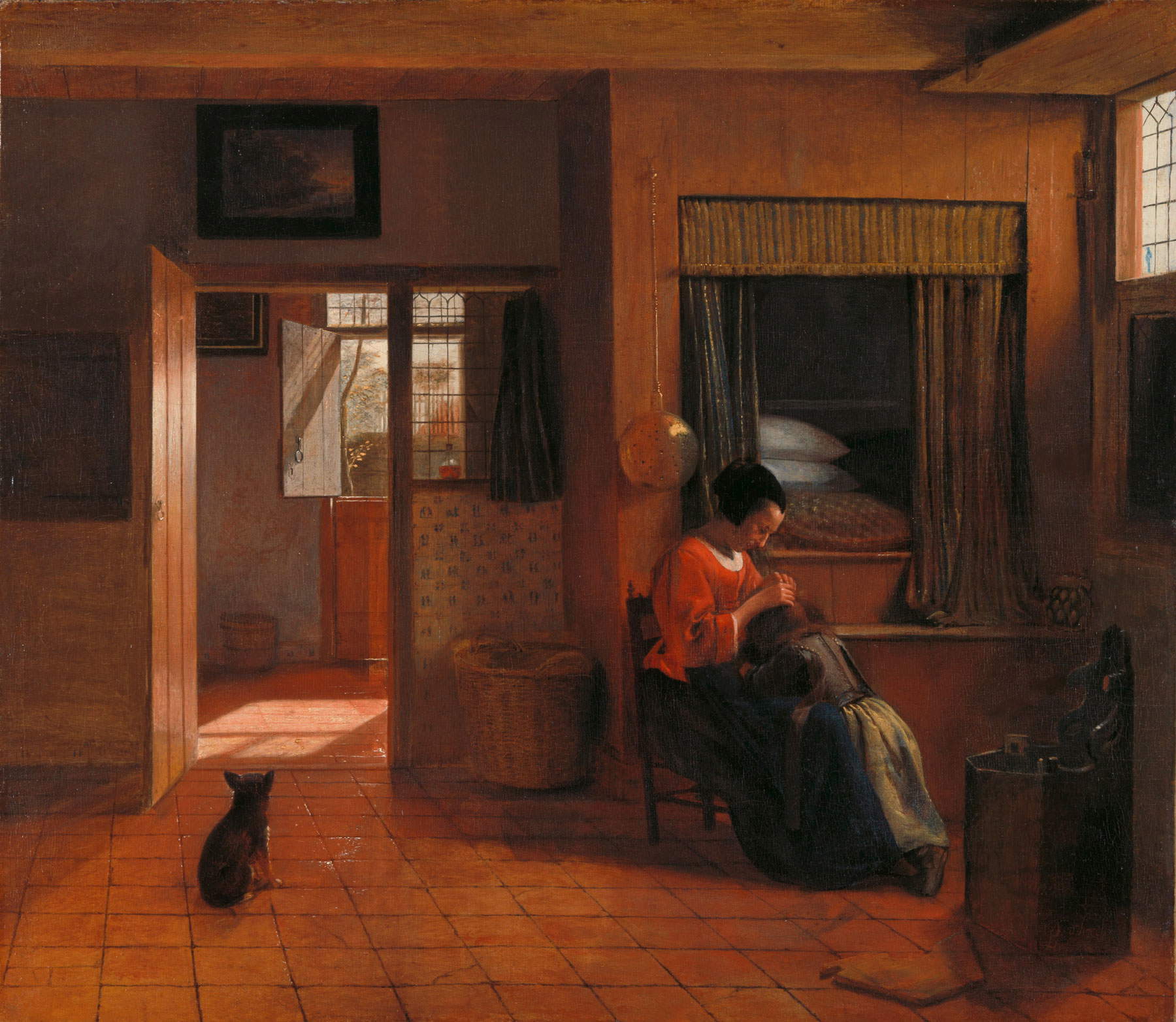 |
| Pieter de Hooch, A Mother’s Duty (c. 1658-1660; oil on panel, 52.5 x 61 cm; Amsterdam, Rijksmuseum) |
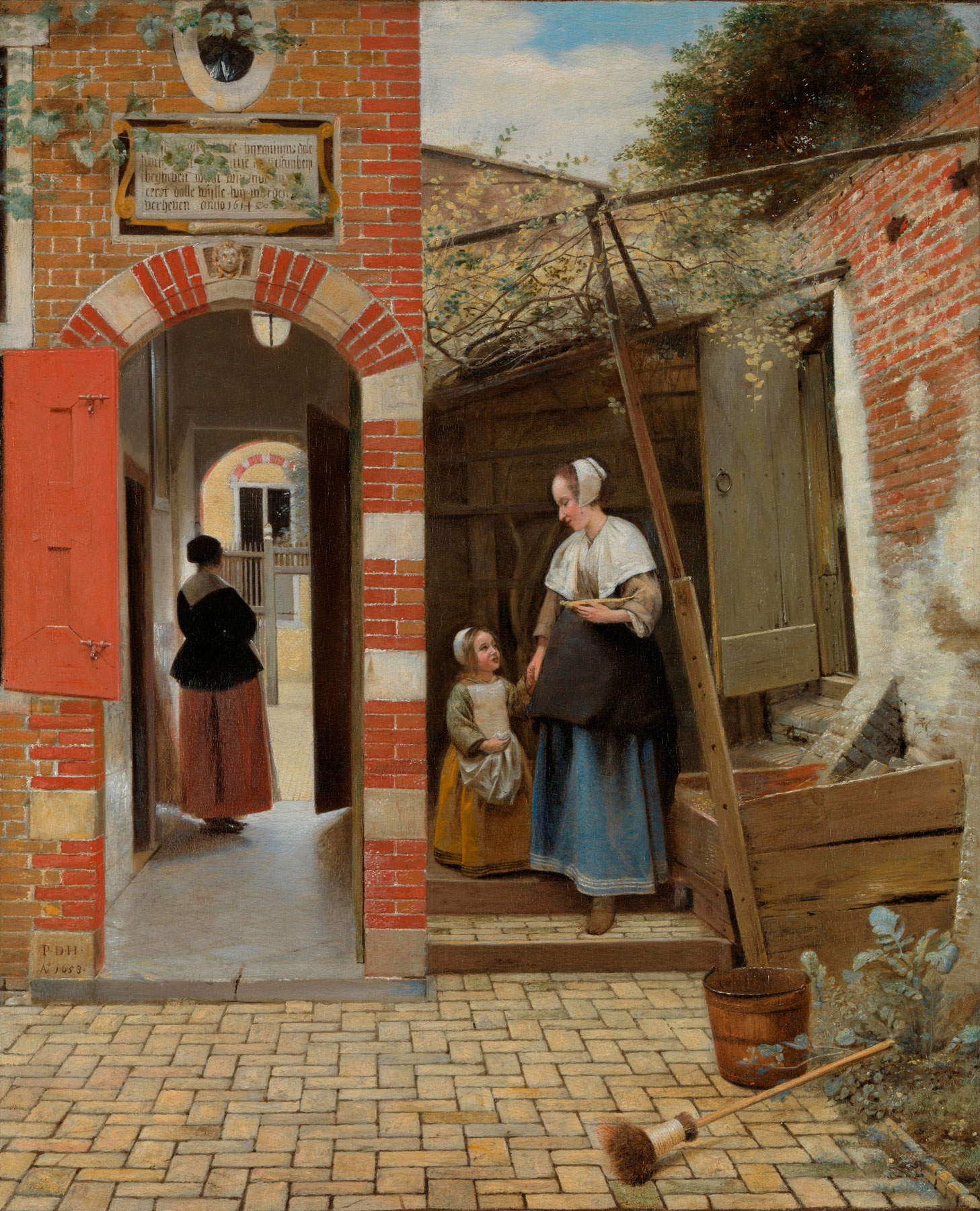 |
| Pieter de Hooch, The Courtyard of a House in Delft (1658; oil on canvas, 73.5 x 60 cm; London, National Gallery) |
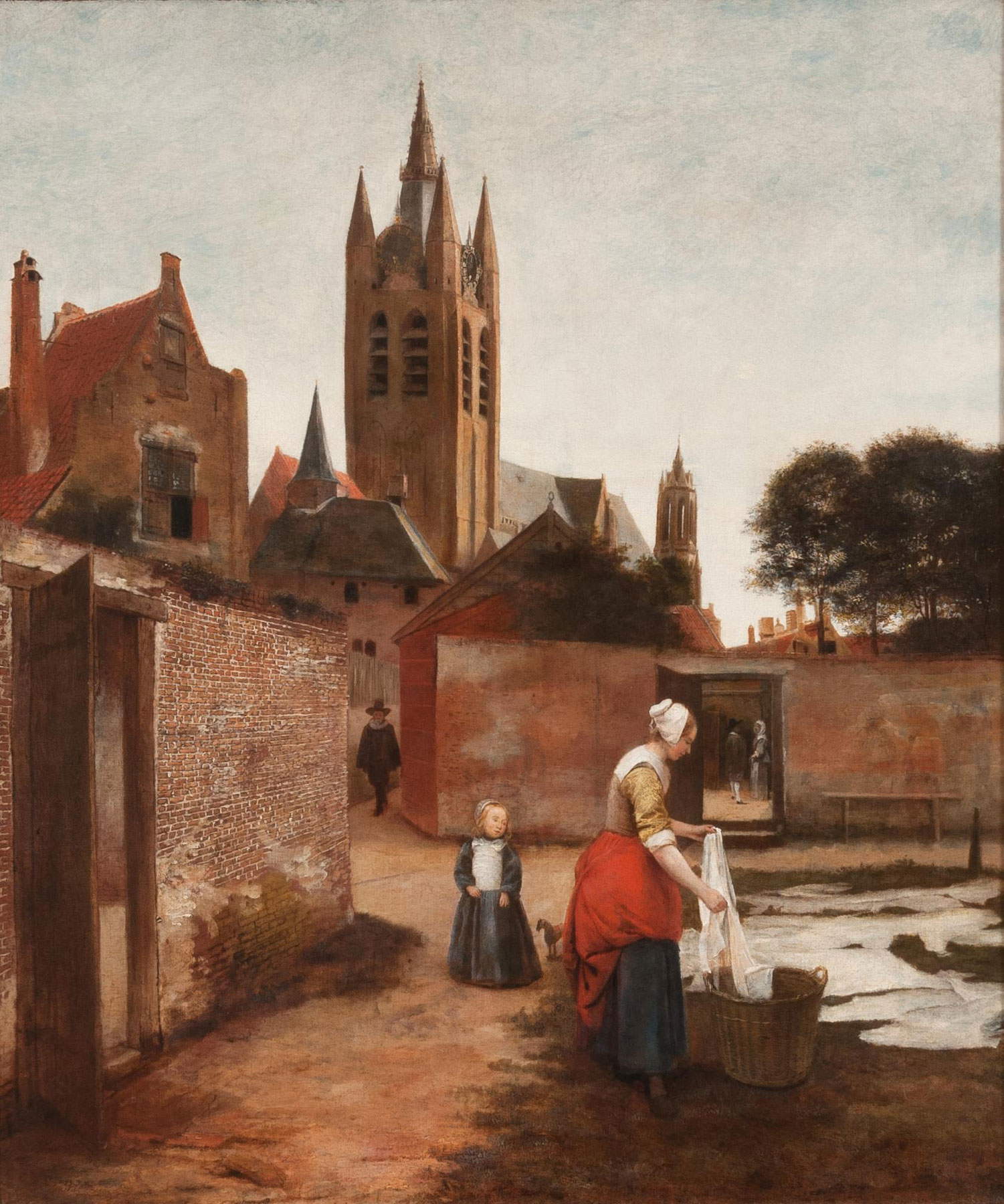 |
| Pieter de Hooch, A Woman and Child in the Open Air (1657-1659; oil on canvas, 73.5 x 63 cm; Private Collection) |
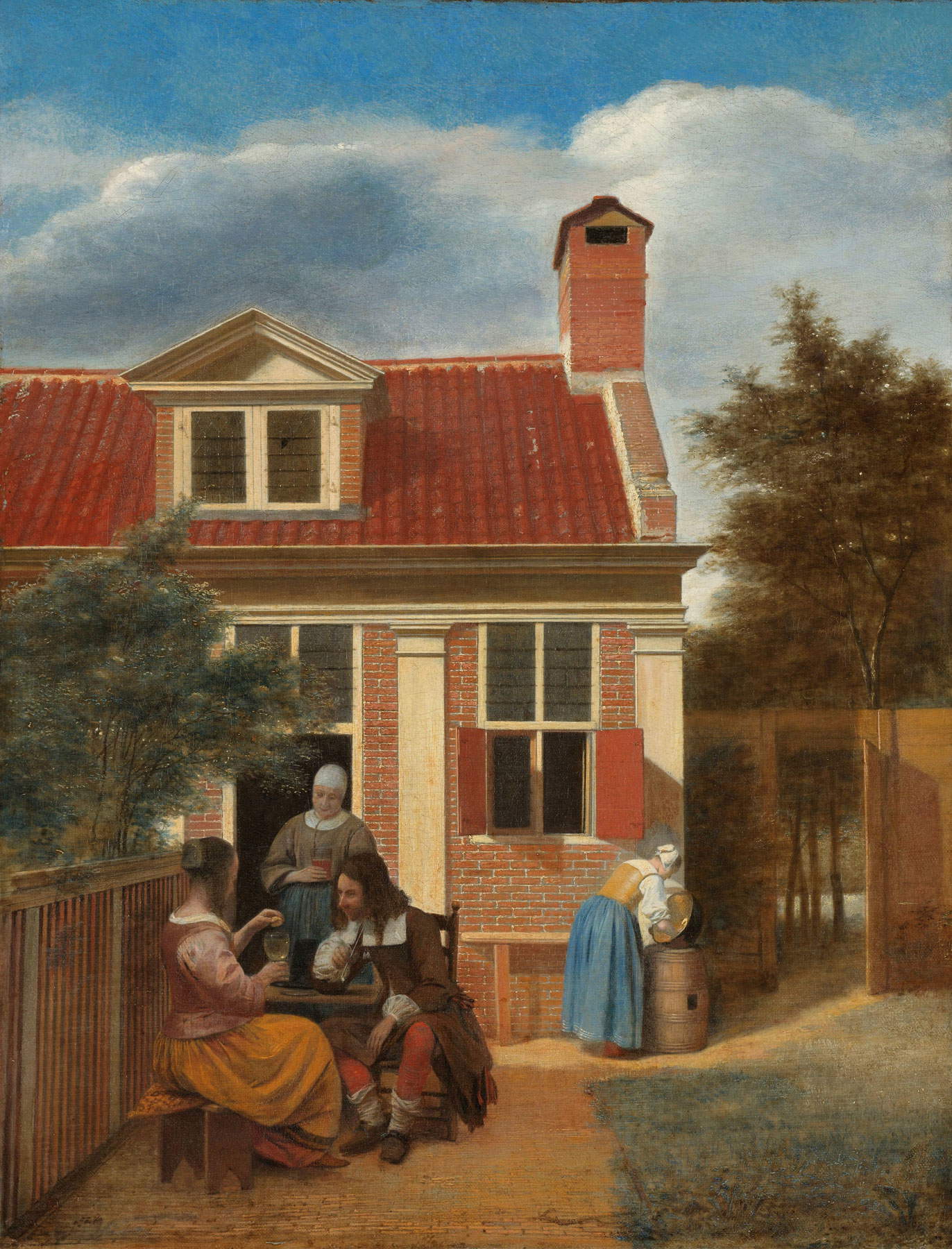 |
| Pieter de Hooch, Figures in a Courtyard (c. 1663-1665; oil on canvas, 60 x 45.7 cm; Amsterdam, Rijksmuseum) |
Never before exhibited in the Netherlands is the 1658 painting, The Courtyard of a House in Delft, from the National Gallery in London. In this case Pieter de Hooch depicts an exterior, a courtyard, but still in a domestic setting, and here too tranquility reigns. The work is divided into two parts: on the right, under an arbor, a young woman is descending two steps holding a little girl by the hand, a sweet understanding can be sensed between the two; on the left, in the passage under an archway, beyond which other houses can be seen, the mother of the child is facing away presumably. The scene is dominated by the presence of red and white bricks, and from the position of the walls it is perceived that the young woman caring for the child and the latter are in an enclosed courtyard; the only opening to the outside world is represented by the houses toward which the mother is looking.
Set instead in an area that was used to spread fabric on the ground so that it would be whiter by theaction of the sun is another painting, now in a private collection, that the artist executed between 1657 and 1659. A young woman in the company of a little girl, who is watching her curiously, is plucking white cloths from wicker baskets and literally spreading them on the ground; some of the stretched pieces can already be seen on the ground. This is an outdoor corner subject to the passage of other people, as can be seen by the approach of a man who is walking down a lane and the couple that can be glimpsed small in the background, in the space beyond the young woman protagonist. In addition, in this painting the artist depicted the characteristic architecture of the city: indeed, in the background one can recognize an architecture similar to the Oude Kerk with its bell tower.
The settings of Pieter de Hooch’s paintings thus transport the viewer directly into the scenes of everyday life in seventeenth-century Delft; silent scenes in front of which one cannot help but empathize and respect that tranquility that invades all of the artist’s masterpieces.
Warning: the translation into English of the original Italian article was created using automatic tools. We undertake to review all articles, but we do not guarantee the total absence of inaccuracies in the translation due to the program. You can find the original by clicking on the ITA button. If you find any mistake,please contact us.